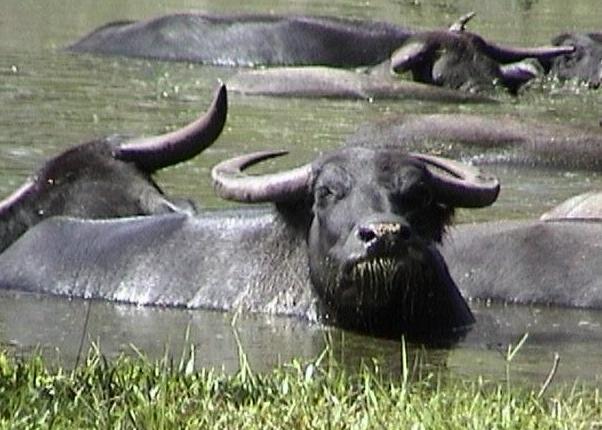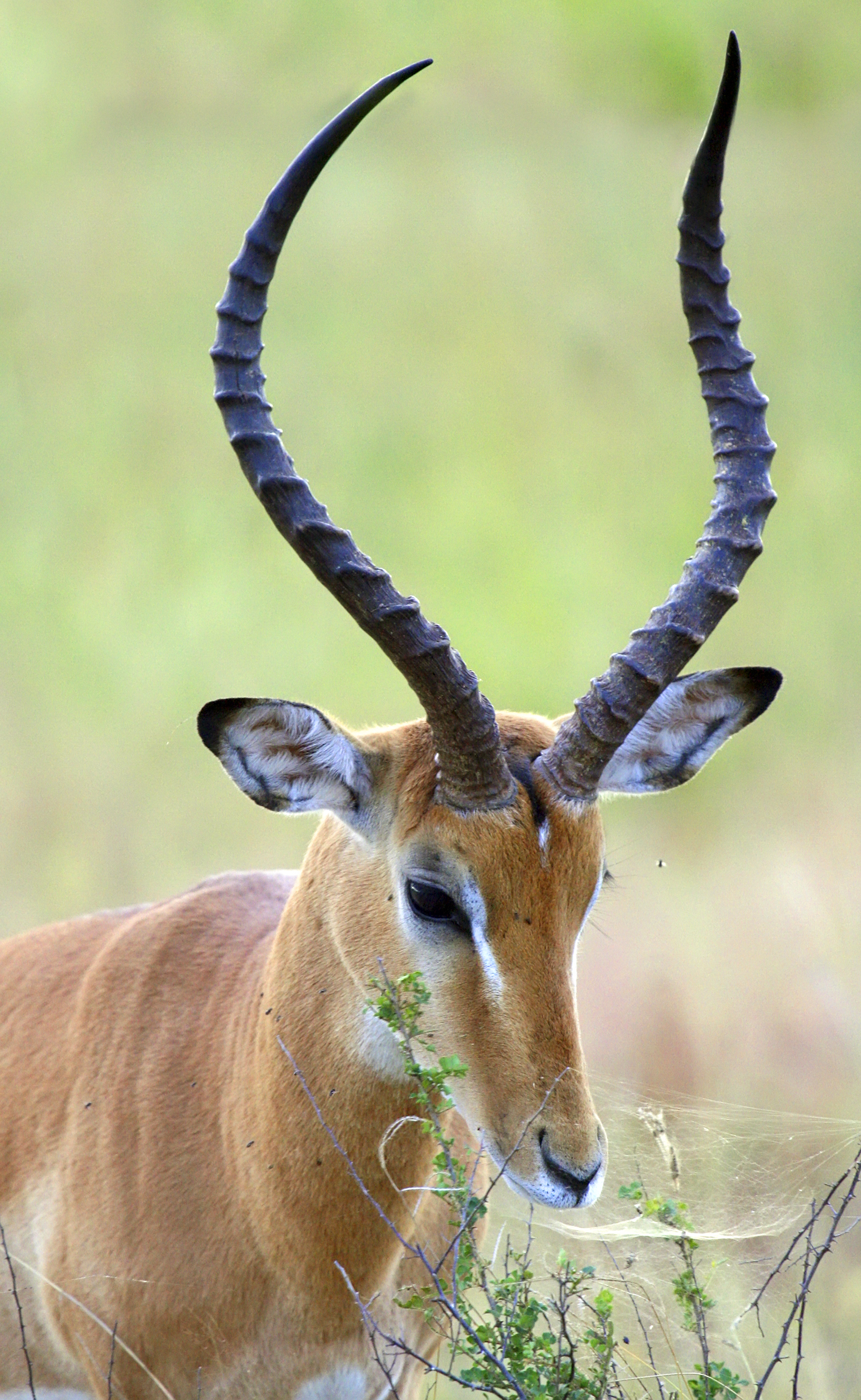|
Sneng
The sneng or snaeng (, "horn") is an aerophone made from an ox horn or water buffalo horn. It is loud enough to call across a distance and has been used in rural environments to signal mealtimes, give warning, call for help or indicate a need to return to the village. It was also used to call domestic elephants in from the field, and hunters communicated with it. Two different types of sneng exist: *The more common one is a side-blown instrument with a rectangular hole on the side of the horn, where a bamboo single- free-reed mouthpiece is fastened with wax. The reed there can be either blown or sucked to produce a tone. Both ends of the horn are open and function as finger holes to change the pitch, the pointed end covered by the left index finger and the wide end covered by the right palm. This type is capable of two notes, tuned a fourth apart. *Another type is an end-blown instrument with the tip of the horn cut off and without the bamboo mouthpiece, like the conventional ... [...More Info...] [...Related Items...] OR: [Wikipedia] [Google] [Baidu] |
Sneng សំលេងស្នែង (somleang Sneng )
The sneng or snaeng (, "horn") is an aerophone made from an ox Horn (anatomy), horn or domestic buffalo, water buffalo horn. It is loud enough to call across a distance and has been used in rural environments to signal mealtimes, give warning, call for help or indicate a need to return to the village. It was also used to call domestic elephants in from the field, and hunters communicated with it. Two different types of sneng exist: *The more common one is a side-blown instrument with a rectangular hole on the side of the horn, where a bamboo single-Free reed aerophone, free-reed Mouthpiece (woodwind), mouthpiece is fastened with wax. The reed there can be either blown or sucked to produce a tone. Both ends of the horn are open and function as finger holes to change the pitch, the pointed end covered by the left index finger and the wide end covered by the right palm. This type is capable of two notes, tuned a fourth apart. *Another type is an end-blown instrument with the tip of ... [...More Info...] [...Related Items...] OR: [Wikipedia] [Google] [Baidu] |
Pepa (instrument)
The pepa is a hornpipe musical instrument that is used in traditional music in Assam, India. In Boro language, it is known as ''Phenpha''. It is usually made with the horn of a buffalo. Significance "Pepa" is a hornpipe which has been used during Bihu celebrations since ancient times. Instruments similar to Pepa are also found among other Bodo-Kachari groups like Garo, Tripuri, Dimasa, etc. The Tibetans, Khmers (Austroasiatic) and ancient Chinese also used similar instruments named ''Rwa-dun'' and ''Sneng'' for religious rituals. Later, it was used as a musical instrument for festive occasions like Bihu. An improved version of Pepa was also developed in the Chutia kingdom which was known as Kaali (made of copper) as mentioned in Deodhai Buranji (where Ahom king Suhungmung brought in Kaali instruments from Sadiya to Sibsagar). As the buffalo population is dwindling gradually in Assam due to shrinking pastoral lands, getting a pepa is currently very difficult. Cost of a ... [...More Info...] [...Related Items...] OR: [Wikipedia] [Google] [Baidu] |
Cambodian Musical Instruments
Traditional Cambodian musical instruments are the musical instruments used in the traditional and classical music of Cambodia. They comprise a wide range of wind, string, and percussion instruments, used by both the Khmer people, Khmer majority as well as the nation's List of ethnic groups in Cambodia, ethnic minorities. File:Shoulder-mounted nipple gong at Angkor Wat.jpg, Soldiers carry drums and a shoulder-mounted nipple gong in relief at Angkor Wat. File:Kse diev at Angkor Wat, North Section, 16th Century.jpg, Kse diev at Angkor Wat, North Section, 16th Century. File:Kongpeat from Angkor Wat.jpg, Khmer gong chimes from Angkor Wat. Woodwind Flute *Khloy () - vertical duct flute made of bamboo, hardwood, or plastic, with buzzing membrane **Khloy ek - smaller in size **Khloy thom - larger in size Free-reed *Sneng () - domestic buffalo, water buffalo or ox horn with a single free reed *Pey pok () - free-reed pipe *Ploy (musical instrument), Ploy () (also called ''m'baut' ... [...More Info...] [...Related Items...] OR: [Wikipedia] [Google] [Baidu] |
Abeng
An Abeng is an animal horn or musical instrument in the language of the Akan people. The word ''abeng'' is from the Twi language in modern-day Ghana, it is a commonly used word in the Caribbean, especially Jamaica, and the instrument is associated with the Maroon people. The Maroons of Jamaica used the horn to communicate over great distances in ways that couldn't be understood by people outside the community. Today the abeng is made from cattle Cattle (''Bos taurus'') are large, domesticated, bovid ungulates widely kept as livestock. They are prominent modern members of the subfamily Bovinae and the most widespread species of the genus '' Bos''. Mature female cattle are calle ... horn and is still used in Maroon communities on ceremonial occasions or to announce important news. See also * Sneng a similar side-blown horn in Cambodia References External links Article with details on Abeng Animal products Natural horns and trumpets {{Aerophone-instrument-s ... [...More Info...] [...Related Items...] OR: [Wikipedia] [Google] [Baidu] |
Blowing Horn
Blowing may refer to: * Air *Breath Breathing (spiration or ventilation) is the neuroscience of rhythm, rhythmical process of moving air into (inhalation) and out of (exhalation) the lungs to facilitate gas exchange with the Milieu intérieur, internal environment, mostly to flu ... *Blowing by a whale, from blowhole (anatomy) Industrial processes * Blowing (glassmaking) * Blowing (textile finishing) * Dry blowing, method to extract gold particles from dry soil without the use of water * Melt blowing, fabrication method of micro-and nanofibers through extrusion Other * ''Blowing'' (album), Japanese-language album by Tokio {{dab ... [...More Info...] [...Related Items...] OR: [Wikipedia] [Google] [Baidu] |
Mouthpiece (woodwind)
The mouthpiece of a woodwind instrument is that part of the instrument which is placed partly in the player's mouth. List of woodwind instruments#Single-reed, Single-reed instruments, List of woodwind instruments#Capped, capped double-reed instruments, and List of woodwind instruments#Closed (fipple), fipple flutes have mouthpieces while List of woodwind instruments#Exposed, exposed double-reed instruments (apart from those using #Pirouettes, pirouettes) and List of woodwind instruments#Open, open flutes do not. The characteristics of a mouthpiece and reed can play a significant role on the sound of the instrument. Single-reed instruments On single-reed instruments, such as the clarinet and saxophone, the mouthpiece is that part to which the reed is attached. Its function is to provide an opening through which air enters the instrument and one end of an bore (wind instruments), air chamber to be set into vibration by the interaction between the air stream and the reed. Single-ree ... [...More Info...] [...Related Items...] OR: [Wikipedia] [Google] [Baidu] |
Free Reed Aerophone
A free reed aerophone is a musical instrument that produces sound as air flows past a vibrating reed (instrument), reed in a frame. Air pressure is typically generated by breath or with a bellows. In the Hornbostel–Sachs system, it is number 412.13 (a member of interruptive free aerophones). Free reed instruments are contrasted with non-free or enclosed reed instruments, where the timbre is fully or partially dependent on the shape of the instrument body, Hornbostel–Sachs number: 42 (flute, reed aerophone, reed, and brass instrument, brass). Operation The following illustrations depict the type of reed typical of harmonicas, pitch pipes, accordions, and reed organs as it goes through a cycle of vibration. One side of the reed frame is omitted from the images for clarity; in reality, the frame completely encloses the reed. Airflow over one side of the reed (labeled “AR”) creates a region of low pressure on that side (see the Bernoulli's principle article for details), cau ... [...More Info...] [...Related Items...] OR: [Wikipedia] [Google] [Baidu] |
Domestic Buffalo
The water buffalo (''Bubalus bubalis''), also called domestic water buffalo, Asian water buffalo and Asiatic water buffalo, is a large bovid originating in the Indian subcontinent and Southeast Asia. Today, it is also kept in Italy, the Balkans, Australia, North America, South America and some African countries. Two extant Type (biology), types of water buffalo are recognized, based on Morphology (biology), morphological and Ethology, behavioural criteria: the river buffalo of the Indian subcontinent and further west to the Balkans, Egypt and Italy; and the swamp buffalo from Assam in the west through Southeast Asia to the Yangtze Valley of China in the east. The wild water buffalo (''Bubalus arnee'') is most probably the ancestor of the domestic water buffalo. Results of a phylogenetic study indicate that the river-type water buffalo probably originated in western India and was domesticated about 6,300 years ago, whereas the swamp-type originated independently from Mainland Sou ... [...More Info...] [...Related Items...] OR: [Wikipedia] [Google] [Baidu] |
Horn (anatomy)
A horn is a permanent pointed projection on the head of various animals that consists of a covering of keratin and other proteins surrounding a core of live bone. Horns are distinct from antlers, which are not permanent. In mammals, true horns are found mainly among the ruminant artiodactyls, in the families Antilocapridae ( pronghorn) and Bovidae ( cattle, goats, antelope etc.). Cattle horns arise from subcutaneous connective tissue (under the scalp) and later fuse to the underlying frontal bone. One pair of horns is usual; however, two or more pairs occur in a few wild species and in some domesticated breeds of sheep. Polycerate (multi-horned) sheep breeds include the Hebridean, Icelandic, Jacob, Manx Loaghtan, and the Navajo-Churro. Horns usually have a curved or spiral shape, often with ridges or fluting. In many species, only males have horns. Horns start to grow soon after birth and continue to grow throughout the life of the animal (except in pronghorns, whi ... [...More Info...] [...Related Items...] OR: [Wikipedia] [Google] [Baidu] |
Aerophone
An aerophone is a musical instrument that produces sound primarily by causing a body of air to vibrate, without the use of strings or membranes (which are respectively chordophones and membranophones), and without the vibration of the instrument itself adding considerably to the sound (or idiophones). According to Curt Sachs: These may be lips, a mechanical reed, or a sharp edge. Also, an aerophone may be excited by percussive acts, such as the slapping of the keys of a flute or of any other woodwind. A free aerophone lacks the enclosed column of air yet, "cause a series of condensations and rarefications by various means." Overview Aerophones are one of the four main classes of instruments in the original Hornbostel–Sachs system of musical instrument classification, which further classifies aerophones by whether or not the vibrating air is contained within the instrument. The first class (41) includes instruments which, when played, do ''not'' contain the vibrating air. ... [...More Info...] [...Related Items...] OR: [Wikipedia] [Google] [Baidu] |






